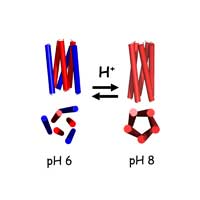
A De Novo Designed Coiled-Coil Peptide with a Reversible pH-Induced Oligomerization Switch
Protein conformational switches have many useful applications but are difficult to design rationally. Here we demonstrate how the isoenergetic energy landscape of higher-order coiled coils can enable the formation of an oligomerization switch by insertion of a single destabilizing element into an otherwise stable computationally designed scaffold. We describe a de novo designed peptide that was discovered to switch between a parallel symmetric pentamer at pH 8 and a trimer of antiparallel dimers at pH 6. The transition between pentamer and hexamer is caused by changes in the protonation states of glutamatic acid residues with highly upshifted pKa values in both oligomer forms. The drastic conformational change coupled with the narrow pH range makes the peptide sequence an attractive candidate for introduction of pH sensing into other proteins. The results highlight the remarkable ability of simple-α helices to self-assemble into a vast range of structural states.
